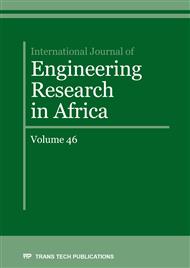[1]
J. Hirsch, Recent development in aluminum for automotive applications, Trans. Nonferrous Metals Soc. China; 24(7) (2014) 1995–(2002).
Google Scholar
[2]
K. Sadek, B. Aour, B. B. Bouiadjra, M. F. Bouanani, F. Khelil, Analysis of Crack Propagation by Bonded Composite for Different Patch Shapes Repairs in Marine Structures: A Numerical Analysis, Int. J. Eng. Res. Afr,35 (2018) 175-184.
DOI: 10.4028/www.scientific.net/jera.35.175
Google Scholar
[3]
T.P Fries, T. Belytschko, The extended/generalized finite element method: An overview of the method and its applications. Int. J. Numer. Meth. Eng. 84(3) (2010) 253–304.
DOI: 10.1002/nme.2914
Google Scholar
[4]
Y. Abdelaziz, A. Hamouine, A survey of the extended finite element. Comput Struct, 86(11) (2008) 1141–1151.
DOI: 10.1016/j.compstruc.2007.11.001
Google Scholar
[5]
T. Belytschko, T. Black, Elastic crack growth in finite elements with minimal remeshing. Int. J. Numer. Meth. Eng, 45, (1999) 601–620.
DOI: 10.1002/(sici)1097-0207(19990620)45:5<601::aid-nme598>3.0.co;2-s
Google Scholar
[6]
J. Melenk, J, I. Babuska, The partition of unity finite element method: Basic theory and application. Comput. Meth. Appl. Mech. Eng, 139, (1996) 289–314.
Google Scholar
[7]
N, Sukumar, N. Moes, B. Moran, T. Belytschko, Extended finite elment method for three-dimesional crack modelling. . Int. J. Numer. Meth. En, 48, (2000) 1549–1570.
DOI: 10.1002/1097-0207(20000820)48:11<1549::aid-nme955>3.0.co;2-a
Google Scholar
[8]
T. Rabczuk, T. Belytschko, A three-dimensional large deformation meshfree method for arbitrary evolving cracks. Comput Methods Appl Mech Eng 196 (2007) 2777–2799.
DOI: 10.1016/j.cma.2006.06.020
Google Scholar
[9]
T. Rabczuk, S. Bordas, G. Zi, On three-dimensional modeling of crack growth using partition of unity methods. Comput. Struct, 88 (2010) 1391–1411.
DOI: 10.1016/j.compstruc.2008.08.010
Google Scholar
[10]
H. Pathak, A. Singh, I.V. Singh, S.K. Yadav, A simple and efficient XFEM approach for 3-D cracks simulations, Int. J. Fract, 181 (2013) 189-208.
DOI: 10.1007/s10704-013-9835-2
Google Scholar
[11]
L. Wu, L.X. Zhang and Y.K. Guo, A Review of the Extended Finite Element for Fracture Analysis of Structures, Appl. Mech. Mat, 444-445 (2013) 96-102.
DOI: 10.4028/www.scientific.net/amm.444-445.96
Google Scholar
[12]
M. Stolarska, D.L. Chopp, N. Moës, T. Belytschko, Modelling crack growth by level sets in the extended finite element method. Int. J. Numer. Methods. Eng. 51 (2001) 943–960.
DOI: 10.1002/nme.201
Google Scholar
[13]
S. Osher, J. Sethian, Frints propagating with curvature-dependent speed:algorithms based on hamilton-jacobi formulations, J. Comput. Phys 79 (1988) 712–49.
DOI: 10.1016/0021-9991(88)90002-2
Google Scholar
[14]
S. Osher, R. P. Fedkiw, Level set methods: An overview and some recent results. J. comput. phys,169 (2001) 463–502.
DOI: 10.1006/jcph.2000.6636
Google Scholar
[15]
G. Ventura, On the elimination of quadrature subcells for discontinuous functions in the extended finite element method, Int. J. Numer. Methods Eng. 66 (2006) 761-95.
DOI: 10.1002/nme.1570
Google Scholar
[16]
D. Holdych, D. Noble, R. Secor, Quadrature rules for triangular and tetrahedral elements with generalized functions, Int. J. Numer. Methods Eng. 73 (2008) 1310-27.
DOI: 10.1002/nme.2123
Google Scholar
[17]
G. Ventura, R. Gracie, T. Belytschko, Fast integration and weight function blending in the extended finite element method, Int. J. Numer. Methods Eng. 77 (2009) 1-29.
DOI: 10.1002/nme.2387
Google Scholar
[18]
S.E. Mousavi, N. Sukumar, Generalized Gaussian quadrature rules for discontinuities and crack singularities in the extended finite element method, Comput. Meth. Appl. Mech. Eng. 199 (2010) 3237-49.
DOI: 10.1016/j.cma.2010.06.031
Google Scholar
[19]
D. Sutula, P. Kerfriden, T. Van Dam, S. P.A. Borda, Minimum energy multiple crack propagation. Part III: XFEM computer implementation and applications, Eng. Fract. Mecha. 191 (2018) 257–276.
DOI: 10.1016/j.engfracmech.2017.08.004
Google Scholar
[20]
M. Malekan, Leandro L. Silva, Felicio B. Barros, Roque L.S. Pitangueira, Samuel S. Penna, Two-dimensional fracture modeling with the generalized/extended finite element method: An object-oriented programming approach, Adv. Eng. Softw. 115 (2018) 168–193.
DOI: 10.1016/j.advengsoft.2017.09.005
Google Scholar
[21]
K. Agathos, G, Ventura, E, Chatzi, S. P. A. Bordas, Stable 3D XFEM/vector level sets for non-planar 3D crack propagation and comparison of enrichment schemes, Int. J. Numer. Methods Engrg. 113 (2018) 252–276.
DOI: 10.1002/nme.5611
Google Scholar
[22]
ASTM Standard E8/E8M-13a, Standard Test Methods for Tension Testing of Metallic Materials, ASTM International, West Conshohocken, PA, (2013).
Google Scholar


